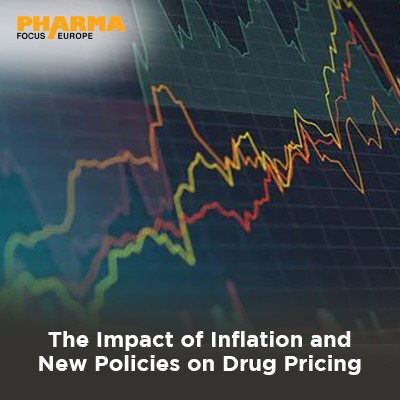
This article explores the intricate relationship between inflation, new policies, and drug pricing in the pharmaceutical industry. It delves into the mechanisms of inflation affecting raw materials, labor, and distribution costs, while also analyzing the impact of price regulation, patent reforms, and value-based pricing policies on stakeholders and future trends in drug pricing strategies.

Drug pricing has long been a contentious issue, balancing the cost of innovation and the need for accessible healthcare. In recent years, the landscape has grown more complex due to rising inflation and the introduction of new policies aimed at controlling drug costs. This article explores how inflation and these policies affect drug pricing, the implications for stakeholders, and potential future directions.
The Mechanisms of Inflation
Inflation refers to the general increase in prices and the fall in the purchasing power of money. In the pharmaceutical industry, inflation affects various components of drug pricing, including raw materials, manufacturing, labor, and distribution.
Rising Costs of Raw Materials
Pharmaceuticals rely heavily on raw materials, which are subject to price fluctuations. Inflation increases the cost of these materials, from active pharmaceutical ingredients (APIs) to packaging materials. Higher material costs inevitably lead to increased production costs.
Labor and Manufacturing Costs
Labor is another significant factor in drug production. As the cost of living rises, so do wages. Higher wages increase the overall cost of manufacturing, which is often passed on to consumers in the form of higher drug prices.
Distribution and Logistics
Inflation also affects the cost of transportation and distribution. Fuel prices, shipping rates, and other logistical costs can rise, adding to the overall expense of bringing a drug to market.
Impact on Research and Development
Inflation can also affect the costs associated with research and development (R&D). Increased expenses in R&D can lead to higher drug prices as companies seek to recoup their investments.
Price Regulation Policies
Governments worldwide have introduced various policies to regulate drug prices. These policies aim to make medications more affordable but can also lead to unintended consequences.
Price Caps and Controls: Some countries implement price caps or controls to limit how much companies can charge for certain medications. While this can reduce drug costs for consumers, it can also discourage investment in new drug development.
Reimbursement Mechanisms: Policies that change how drugs are reimbursed by insurance companies and government programs can influence pricing strategies. For example, reference pricing, where the cost of a drug is compared to similar drugs in the market, can pressure manufacturers to lower prices.
Patent Reforms
Patent policies significantly impact drug pricing. Reforms that shorten patent exclusivity periods can lead to earlier entry of generic competitors, reducing prices. However, they can also reduce the incentives for developing new drugs.
Importation Policies
Some policies allow for the importation of cheaper drugs from other countries. This can increase competition and lower prices domestically but may raise concerns about the quality and safety of imported medications.
Value-Based Pricing
New policies are increasingly focusing on value-based pricing, where the price of a drug is tied to its effectiveness and the value it provides to patients. This approach aims to ensure that drug prices reflect their actual benefit but requires robust mechanisms for assessing value.
Pharmaceutical Companies
For pharmaceutical companies, inflation and new policies present both challenges and opportunities. Rising costs can squeeze profit margins, while price controls and reimbursement changes can affect pricing strategies. Companies may need to innovate in cost management and efficiency to maintain profitability.
Healthcare Providers
Healthcare providers may face challenges in managing drug budgets and ensuring patients have access to necessary medications. They may need to work more closely with payers and pharmaceutical companies to navigate pricing pressures.
Patients
Patients are directly impacted by changes in drug pricing. While policies aimed at reducing costs can make medications more affordable, there may be trade-offs in terms of access to the latest treatments. Inflation can further strain patients' finances, particularly for those requiring long-term or expensive therapies.
Payers and Insurers
Payers and insurers must adapt to changing pricing landscapes. They may implement more stringent formulary management and negotiate more aggressively with drug manufacturers. Value-based pricing models may become more prevalent, focusing on ensuring value for money in healthcare spending.
Innovation in Cost Management
Pharmaceutical companies are likely to invest more in innovative cost management strategies. This includes adopting advanced manufacturing technologies, optimizing supply chains, and leveraging data analytics to improve efficiency.
Enhanced Collaboration
There may be increased collaboration between stakeholders to address the challenges posed by inflation and new policies. This includes partnerships between pharmaceutical companies, healthcare providers, payers, and policymakers to develop sustainable pricing models.
Emphasis on Value-Based Care
The shift towards value-based care is expected to continue. This approach aligns pricing with the outcomes and benefits provided by medications, promoting more sustainable and equitable healthcare systems.
Global Trends and Regulatory Harmonization
Global trends, such as the increasing emphasis on generic and biosimilar drugs, will continue to shape drug pricing. Regulatory harmonization efforts may also emerge, aiming to standardize pricing policies across different regions.
The impact of inflation and new policies on drug pricing is multifaceted and complex. While these factors present significant challenges, they also offer opportunities for innovation and collaboration. By navigating these changes effectively, stakeholders can work towards a more balanced and sustainable drug pricing landscape that ensures access to affordable medications while supporting continued innovation in the pharmaceutical industry.